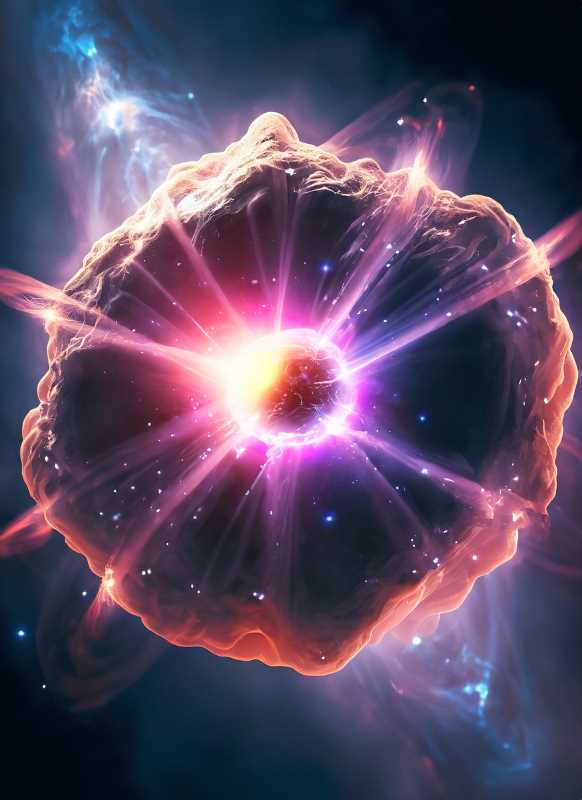What Supernovae Hide in Their Event Horizons
Supernovae, cosmic explosions of massive stars, birth neutron stars or black holes, while forging essential heavy elements like iron. A celestial spectacle that shapes the universe's very fabric.

In the vast cosmos, a remarkable celestial phenomenon takes center stage – the Type II supernova. These cosmic explosions, characterized by their cataclysmic brilliance, play a pivotal role in shaping the universe, from birthing new stars to forging the densest objects known to science. In this article, we embark on an exhilarating journey to unravel the enigma of supernovae, exploring the intricate processes that transpire within these stellar crucibles.
Imagine a star, eight times more massive than our Sun, nearing the end of its stellar voyage. Deep within its core, temperatures soar to a staggering five billion degrees Kelvin, causing a dramatic transformation. Here, iron-56, the cosmic alchemist's final creation, takes center stage. Under such extreme conditions, iron-56 undergoes a process called photodisintegration, breaking apart and yielding 13 helium particles and four neutrons. Unlike the nuclear reactions seen in lighter elements, these interactions are endoenergetic, siphoning energy away from the star's core.
The consequence is a spectacularly violent collapse of the star's central region, a gravitational cataclysm that unfolds with breathtaking swiftness. This gravitational freefall results in the release of an enormous amount of energy, setting off a shock wave that ripples outward through the star's layers. As this shockwave progresses, it triggers nuclear reactions, forging heavy elements within the star's outer shell. These newly minted heavy elements are expelled into the cosmic abyss, enriching the interstellar medium with the raw materials of stars and planets.
Yet, at the heart of this cosmic maelstrom, another astonishing transformation takes place. Amidst the chaos, atomic nuclei disintegrate, and their constituent particles morph into neutrons. This transformation marks the birth of a neutron star, a celestial entity of unfathomable density, boasting a mind-boggling mass of one billion tons per cubic centimeter. These enigmatic objects, often no larger than a city, defy comprehension with their exotic properties.
Moreover, the outcome of these stellar fireworks is not always a neutron star. The fate of many Type II supernovae remains a mystery, as they may give rise to one of the cosmos' most enigmatic creations: black holes. These gravitational behemoths, characterized by their insatiable appetite for matter, could serve as cosmic vaults, trapping the heavy elements forged in the crucible of nuclear reactions. The precise ratio of massive stars culminating in neutron stars versus black holes remains one of the universe's well-guarded secrets.

From an elemental perspective, Type II supernovae are cosmic forges that fashion the universe's heavy elements. Elements like oxygen, neon, magnesium, sodium, and aluminum, vital to the composition of planets and life as we know it, owe their existence to these stellar cataclysms. Among these heavy elements, the formation of iron, manganese, and chromium is attributed primarily to the fiery death throes of massive stars.
Not all supernovae are born from massive stars, though. A subclass known as Type Ia supernovae emerges from a different cosmic dance. These stellar detonations occur within white dwarf stars, celestial remnants of stars with masses less than 1.4 times that of our Sun, known as the Chandrasekhar limit. When a white dwarf in a binary system accretes mass from its companion star, it inches closer to this critical mass limit. Eventually, a thermonuclear instability erupts within its core, unleashing the fiery spectacle of a supernova. These Type Ia supernovae are responsible for generating elements like iron, manganese, and chromium, adding to the cosmic tapestry of heavy elements.
In summary, the story of supernovae is a gripping cosmic saga, a tale of creation and destruction on a cosmic scale. These extraordinary events, whether they give birth to neutron stars or black holes, are the universe's alchemical laboratories, forging the very elements that make life as we know it possible. As we gaze at the night sky, we can't help but be humbled by the cosmic fireworks of supernovae, these celestial forces that shape the cosmos itself.
In-Text Citation: ‘Evolución de La Composición Química Del Universo’. Revista de La Universidad de México, https://www.revistadelauniversidad.mx/articles/84f43983-4ac5-4e19-90ea-ecfafd73f26e/evolucion-de-la-composicion-quimica-del-universo. Accessed 14 Sept. 2023.




